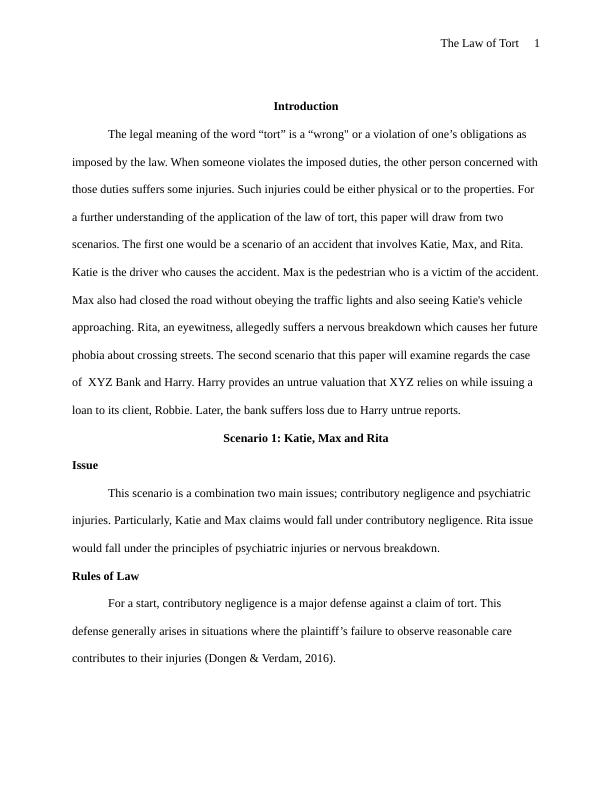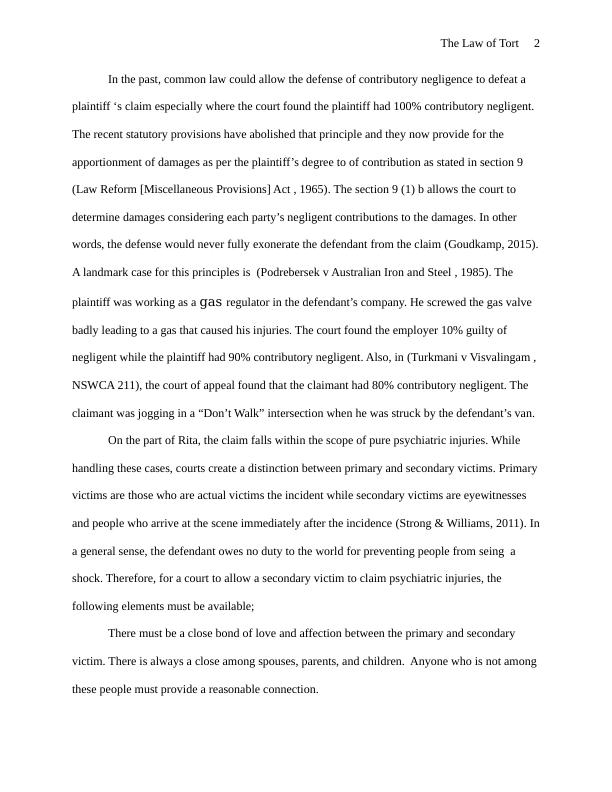The Law of Tort: Contributory Negligence and Pure Economic Loss
Added on 2023-06-15
7 Pages2059 Words221 Views
THE LAW OF TORT
Author
Name of The Class
Name of The Professor
School
City and State
Date
Author
Name of The Class
Name of The Professor
School
City and State
Date

The Law of Tort 1
Introduction
The legal meaning of the word “tort” is a “wrong" or a violation of one’s obligations as
imposed by the law. When someone violates the imposed duties, the other person concerned with
those duties suffers some injuries. Such injuries could be either physical or to the properties. For
a further understanding of the application of the law of tort, this paper will draw from two
scenarios. The first one would be a scenario of an accident that involves Katie, Max, and Rita.
Katie is the driver who causes the accident. Max is the pedestrian who is a victim of the accident.
Max also had closed the road without obeying the traffic lights and also seeing Katie's vehicle
approaching. Rita, an eyewitness, allegedly suffers a nervous breakdown which causes her future
phobia about crossing streets. The second scenario that this paper will examine regards the case
of XYZ Bank and Harry. Harry provides an untrue valuation that XYZ relies on while issuing a
loan to its client, Robbie. Later, the bank suffers loss due to Harry untrue reports.
Scenario 1: Katie, Max and Rita
Issue
This scenario is a combination two main issues; contributory negligence and psychiatric
injuries. Particularly, Katie and Max claims would fall under contributory negligence. Rita issue
would fall under the principles of psychiatric injuries or nervous breakdown.
Rules of Law
For a start, contributory negligence is a major defense against a claim of tort. This
defense generally arises in situations where the plaintiff’s failure to observe reasonable care
contributes to their injuries (Dongen & Verdam, 2016).
Introduction
The legal meaning of the word “tort” is a “wrong" or a violation of one’s obligations as
imposed by the law. When someone violates the imposed duties, the other person concerned with
those duties suffers some injuries. Such injuries could be either physical or to the properties. For
a further understanding of the application of the law of tort, this paper will draw from two
scenarios. The first one would be a scenario of an accident that involves Katie, Max, and Rita.
Katie is the driver who causes the accident. Max is the pedestrian who is a victim of the accident.
Max also had closed the road without obeying the traffic lights and also seeing Katie's vehicle
approaching. Rita, an eyewitness, allegedly suffers a nervous breakdown which causes her future
phobia about crossing streets. The second scenario that this paper will examine regards the case
of XYZ Bank and Harry. Harry provides an untrue valuation that XYZ relies on while issuing a
loan to its client, Robbie. Later, the bank suffers loss due to Harry untrue reports.
Scenario 1: Katie, Max and Rita
Issue
This scenario is a combination two main issues; contributory negligence and psychiatric
injuries. Particularly, Katie and Max claims would fall under contributory negligence. Rita issue
would fall under the principles of psychiatric injuries or nervous breakdown.
Rules of Law
For a start, contributory negligence is a major defense against a claim of tort. This
defense generally arises in situations where the plaintiff’s failure to observe reasonable care
contributes to their injuries (Dongen & Verdam, 2016).

The Law of Tort 2
In the past, common law could allow the defense of contributory negligence to defeat a
plaintiff ‘s claim especially where the court found the plaintiff had 100% contributory negligent.
The recent statutory provisions have abolished that principle and they now provide for the
apportionment of damages as per the plaintiff’s degree to of contribution as stated in section 9
(Law Reform [Miscellaneous Provisions] Act , 1965). The section 9 (1) b allows the court to
determine damages considering each party’s negligent contributions to the damages. In other
words, the defense would never fully exonerate the defendant from the claim (Goudkamp, 2015).
A landmark case for this principles is (Podrebersek v Australian Iron and Steel , 1985). The
plaintiff was working as a gas regulator in the defendant’s company. He screwed the gas valve
badly leading to a gas that caused his injuries. The court found the employer 10% guilty of
negligent while the plaintiff had 90% contributory negligent. Also, in (Turkmani v Visvalingam ,
NSWCA 211), the court of appeal found that the claimant had 80% contributory negligent. The
claimant was jogging in a “Don’t Walk” intersection when he was struck by the defendant’s van.
On the part of Rita, the claim falls within the scope of pure psychiatric injuries. While
handling these cases, courts create a distinction between primary and secondary victims. Primary
victims are those who are actual victims the incident while secondary victims are eyewitnesses
and people who arrive at the scene immediately after the incidence (Strong & Williams, 2011). In
a general sense, the defendant owes no duty to the world for preventing people from seing a
shock. Therefore, for a court to allow a secondary victim to claim psychiatric injuries, the
following elements must be available;
There must be a close bond of love and affection between the primary and secondary
victim. There is always a close among spouses, parents, and children. Anyone who is not among
these people must provide a reasonable connection.
In the past, common law could allow the defense of contributory negligence to defeat a
plaintiff ‘s claim especially where the court found the plaintiff had 100% contributory negligent.
The recent statutory provisions have abolished that principle and they now provide for the
apportionment of damages as per the plaintiff’s degree to of contribution as stated in section 9
(Law Reform [Miscellaneous Provisions] Act , 1965). The section 9 (1) b allows the court to
determine damages considering each party’s negligent contributions to the damages. In other
words, the defense would never fully exonerate the defendant from the claim (Goudkamp, 2015).
A landmark case for this principles is (Podrebersek v Australian Iron and Steel , 1985). The
plaintiff was working as a gas regulator in the defendant’s company. He screwed the gas valve
badly leading to a gas that caused his injuries. The court found the employer 10% guilty of
negligent while the plaintiff had 90% contributory negligent. Also, in (Turkmani v Visvalingam ,
NSWCA 211), the court of appeal found that the claimant had 80% contributory negligent. The
claimant was jogging in a “Don’t Walk” intersection when he was struck by the defendant’s van.
On the part of Rita, the claim falls within the scope of pure psychiatric injuries. While
handling these cases, courts create a distinction between primary and secondary victims. Primary
victims are those who are actual victims the incident while secondary victims are eyewitnesses
and people who arrive at the scene immediately after the incidence (Strong & Williams, 2011). In
a general sense, the defendant owes no duty to the world for preventing people from seing a
shock. Therefore, for a court to allow a secondary victim to claim psychiatric injuries, the
following elements must be available;
There must be a close bond of love and affection between the primary and secondary
victim. There is always a close among spouses, parents, and children. Anyone who is not among
these people must provide a reasonable connection.

End of preview
Want to access all the pages? Upload your documents or become a member.
Related Documents
Law of Tort: Negligencelg...
|7
|1228
|469
Commercial Law: Negligence and Misrepresentationlg...
|9
|1821
|125
Business Law Assignmentlg...
|7
|1331
|428
Legal Position of Bob in a Negligence Claimlg...
|7
|1312
|392
Commercial Law: Negligence and Contributory Negligencelg...
|7
|1476
|387
The Tort of Negligencelg...
|7
|2025
|209